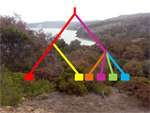Understanding the factors promoting species formation is a major task in evolutionary biology research. In this project, the evolutionary history of the six putative species included within the Californian scrub white oak species complex has been studied. To infer the relative importance of geographical isolation and ecological divergence in driving the speciation process, authors have first analysed inter- and intra-specific patterns of genetic differentiation and employed an approximate Bayesian computation framework to evaluate different plausible scenarios of species divergence. In a second step, the inferred divergence pathways has been linked with current and past species distribution models, and tested for niche differentiation and phylogenetic niche conservatism across taxa. Analyses showed that the most plausible scenario is the one considering the divergence of two main lineages followed by a more recent pulse of speciation. Genotypic data in conjunction with species distribution models and niche differentiation analyses support that different factors (geography vs. environment) and modes of speciation (parapatry, allopatry and maybe sympatry) have played a role in the divergence process within this complex. This study shows that different mechanisms can drive divergence even among closely related taxa representing early stages of species formation and exemplifies the importance of adopting integrative approaches to get a better understanding of the speciation process and the evolutionary phenomena contributing to generate biodiversity. informacion[at]ebd.csic.es: Ortego et al (2015) Evolutionary and demographic history of the Californian scrub white oak species complex: an integrative approach. Mol Ecol 24, 6188-6208 doi: 10.1111/mec.13457
http://onlinelibrary.wiley.com/doi/10.1111/mec.13457/full

 Las altas temperaturas están provocando que las lagunas y las marismas de Doñana pierdan agua rápidamente
Las altas temperaturas están provocando que las lagunas y las marismas de Doñana pierdan agua rápidamente




